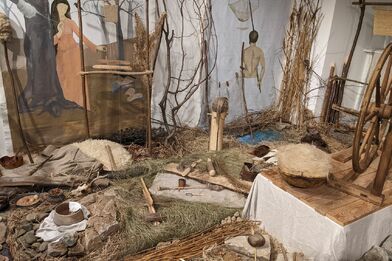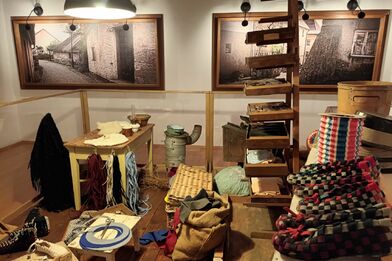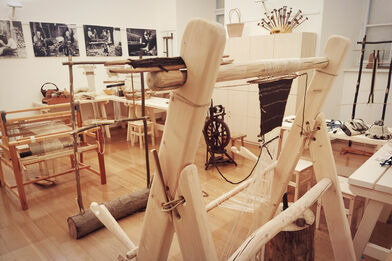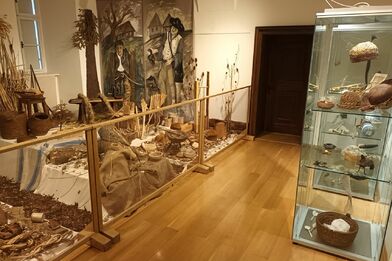Extinct World of Handicraft
The permanent exhibition called The Lost World of Handicraft is dedicated to traditional technologies for processing natural materials. It focuses on humanity’s relationships to certain natural materials and its desire to reshape them for its own needs, thus reflecting in a multifaceted way the exhaustibility and renewability of natural resources.
Exhibitions in all the halls present the displayed traditional handicraft technologies using developed processes. These are exhibited in a manner as if the manufacturer had been there just moments ago. There are the required tools and products here not only in the final form, but also in various stages of production. The original pieces in the collection are supplemented with replicas made by CETRAT Příbor so that the entire collection makes sense and nothing is missing that would hinder understanding of the entire situation.
I. Made from Scraps. About Příbor Footwear Plaited on a Mould
The folk culture milieu managed to efficiently use the remnant or scrap material and work pragmatically with the principles of recycling. This approach is documented by the original footwear made in the past by the technique of plaiting cloth or felt strips. The cloth strips were obtained by cutting up disused old coats and the felt strips from discarded brims produced in the felt hat production. Production of hat brims was widespread mainly in the areas around large hat operations. They were made mainly by people from poor backgrounds using a few simple production tools.
II. After a Magic Fibre. About Historical Processing of Textile Fibres of Flax, Nettle and Wool
From Fairy Tales, Primeval Ages, Middle Ages, Folk Culture to Textile Crisis during the World War I
Clothing is very important for present-day society, as it is an essential part of our lives. Textile production was an absolutely crucial activity even in the past. This exhibition room presents the journey from the Stone Age to the beginning of the 20th century, arriving at the seemingly ordinary thread. The exhibition starts symbolically with the story of a girl who rescued her enchanted brothers using a magic shirt made from nettle. The journey toward the thread continues through the Stone Age, presented by products made of nettle fibre, until the Bronze Age. In this period of time, the flax processing is depicted. The funeral urn from the Bronze Age with remains coming from the large burial-ground uncovered by the archaeological survey in the cadastre of Příbor is wrapped in the flax. The Iron Age is represented by sheep wool processing. The Middle Ages are characterised by a combination of a spinning wheel and late-Gothic statuette of the Virgin Mary, depicting the importance of the women’s qualities associated with production of the necessary threads.
The biggest collection of items brings us to the 19th century, to the traditional rural setting where the flax processing was important, but the nettle fibre also played a special role.
The figurative line of this exhibition finishes with the textile crisis during World War I, when the catastrophic shortage of cotton and wool forced people to resort to the original fibre plants, such as the nettle, almost forgotten at that time.
III. Fruits of Nature. About Natural Material Processing (bast, bark, polypore, cotton-grass, grass, sedge, hair, horsehair, feathers, reedmace, straw, …)
In the region of the Western Carpathians, even at the beginning of the 20th century, one could encounter a number of simple technologies for processing of natural materials that were readily available mainly to people whose living or working space was directly related to the forest boundary. As the mountain settlements were remote places, a lot of such archaic skills were passed down until when they could be properly documented and described. However, this does not mean that time stopped and the primeval technologies remained preserved here for centuries in an unchanged form. It should not be forgotten that a man, if he could, despite the habits ingrained for generations, always resorted to more easily attainable and less demanding for work offered by modern innovations. However, if he was far away from these opportunities and these became unavailable, he was able to return back to the past in a certain way and basically relocate the simple processing of natural materials to make items for his day-to-day urgent needs.
IV. Personal experience. About what it is like to try some techniques on your own
The fourth exhibition hall is very specific, and its task is to consolidate the information and feelings learned in the previous halls. In this hall, the visitor is no longer separated from the museum articles by barriers. It is an exhibiting section full of products, materials and functional tools with a presentation of selected handicraft technologies that are not designated for observing, but trying. The items in this hall are to be mainly explored by touch. Only when we can feel history, try it with our own hands, can we talk about real understanding. You will be guided by an experienced lecturer who will also practically demonstrate the exhibited techniques.




